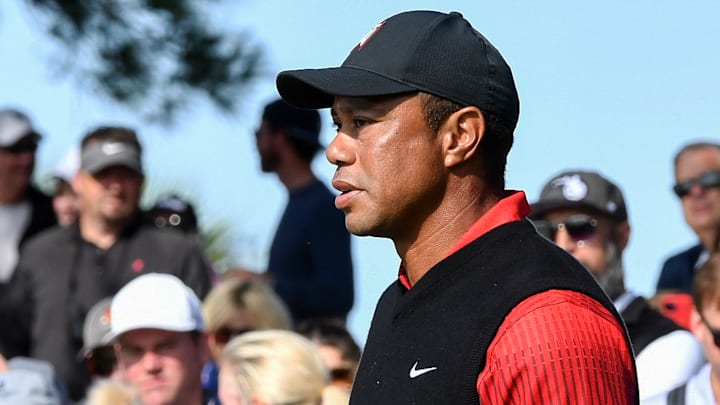Eldrick Tont Woods may not be a household name, but you’ve definitely heard of him. Better known as Tiger Woods, this child golf prodigy-turned-sports legend is one of the most decorated athletes in history, with 15 majors wins and 82 PGA Tour wins. For more, including why you know him as Tiger rather than Eldrick, keep reading.
1. Tiger Woods got his nickname from a soldier.

Woods—who was born on December 30, 1975—got his nickname from his father, Earl. While in the U.S. Army during the Vietnam War, Earl met and befriended a deputy province chief for the Army of the Republic of Vietnam named Vuong Dang Phong. Woods nicknamed Phong “Tiger” for his courage in battle. Later, Earl adopted the name for his son. According to Golf Digest, Phong had gone missing in Vietnam; by giving his son the name, Earl—who predicted Eldrick would be famous—believed it might prompt Phong to reach out if he was still alive. (Sadly, Phong died in 1976, though the Woods family wouldn’t know that until Golf Digest conducted a search for him in 1997.)
As for his middle name, Tont, it likely came from his mother Kultida’s Thai heritage. Tont means beginning in Thai.
2. Woods played golf with Bob Hope at the age of 2.
Earl Woods believed his son would be a golf prodigy, and he didn’t waste much time informing the rest of the world about it. At age 2, Tiger Woods appeared on The Mike Douglas Show to demonstrate his skills. (Douglas had spotted Woods at a driving range and asked him to appear.) Woods can be seen taking swings while Douglas’s other guests, Bob Hope and Jimmy Stewart, look on.
It wasn’t the last time Hope and Woods would cross paths: After Woods turned pro at age 20 in 1996, organizers for The Bob Hope Classic golf tournament tried to get him to participate, but he declined because of his schedule.
3. He could have once been considered legally blind.

Having excellent vision is crucial in golf, which demands exceptional hand-eye coordination. Yet Woods had some challenges in that department: He was nearsighted. He once said he would be considered legally blind without the aid of prescription glasses or contacts. In 1999, he underwent corrective eye surgery to resolve the issue. In 2007, he had the surgery performed a second time.
4. Woods made a Nike commercial that prompted disbelief.
Woods’s ability (and marketability) resulted in some rich endorsement deals, including a five-year, $40 million contract with Nike in 1996 that was re-upped in 2000 for an estimated $100 million. In between, Woods shot a commercial for the brand that caused a stir even among non-sports fans. In the spot, which you can view above, Woods bounces a golf ball on his club for nearly 30 seconds before hitting it into the horizon.
The footage was real and shot on a break from another commercial Woods was filming that day. Director Doug Liman noticed Woods bouncing the ball to pass time and decided to film it. It took Woods just a few takes. After three, Liman jokingly told him he was “choking under pressure.” Woods nailed it on the fourth.
5. Woods may have made other golfers play worse.

In 2011, Northwestern University economist Jennifer Brown published a study in which she examined how players fared when competing against Woods between 1999 and 2010. When Woods was involved in a PGA tournament, players performed more poorly, adding nearly a full stroke to their game. Brown posited it was part of “the superstar effect,” where participants perform worse than they otherwise would because they’re around exceptional talent. Brown theorized that someone with superior skills—be it an athlete or salesperson—could be a disincentive, with others feeling their chances have been reduced. According to Brown, Woods may have earned as much as $6 million as a result of their diminished performances.
6. Some golf courses were “Tiger-proofed.”

You know you’ve had a radical effect on sports when the playing field changes in response to your dominance. That’s what happened in 2001, when Augusta National added 300 yards to its 6985-yard course after Woods won numerous major titles. The move was ostensibly to address the ability of modern players like Woods to hit the ball harder and farther, a step that became known as “Tiger-proofing” a course. Other courses followed suit. It didn’t quite work: Woods hit 12 under par at the Augusta National in 2002 and won. Again.
Woods has designed some courses of his own under his TGR Designs banner, with the latest announced for Park City, Utah, in 2023.
7. Woods’s video game had to be recalled due to some hidden swear words.

Famous athletes often become the face of popular video games, and Woods is no exception. In 1999, Electronic Arts issued Tiger Woods ’99 PGA Tour for Sony’s PlayStation platform. Almost immediately, the company had to recall 100,000 copies of the game. Unbeknownst to them, a rogue programmer had inserted a clip from South Park featuring profanity. While the clip wasn’t easily accessible—a player would have had to search for it on a PC—EA opted to have the game pulled from shelves.
8. Woods once competed for a winner-take-all prize.

In 2018, Woods agreed to pit his skills against those of fellow golf legend Phil Mickelson. In what was touted as The Match and airing on pay-per-view, Mickelson outlasted Woods in 22 holes to earn the $9 million prize. It may be hard for Mickelson to feel as though he has bragging rights, however: At the time, Woods had 14 majors wins to Mickelson’s five. Today, it’s 15, second only to Jack Nicklaus’s 18.
